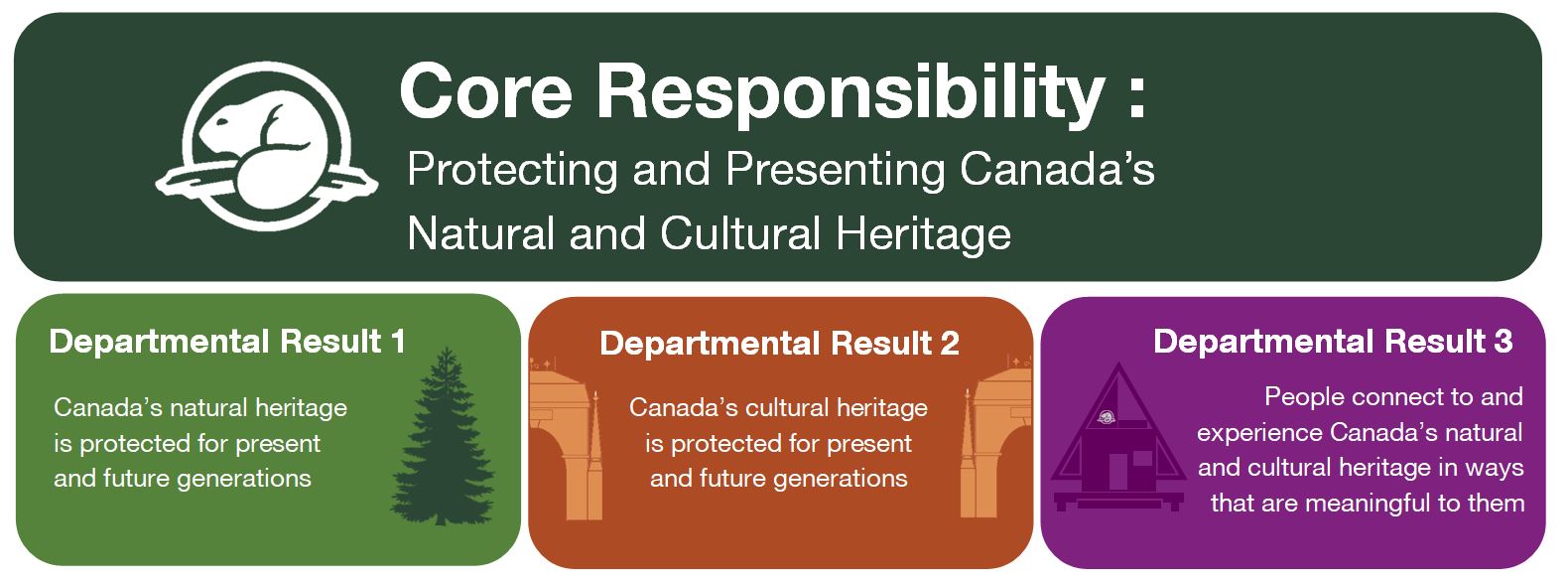Parks Canada’s departmental plan for fiscal year 2024 to 2025 at a glance
A departmental plan describes a department’s priorities, plans and associated costs for the upcoming three fiscal years.
Read the full departmental planDepartmental plan for the fiscal year 2024 to 2025
Parks Canada Agency objectives, initiatives and planned results for fiscal year 2024 to 2025
Supplementary information tables
Raison d’être, mandate and role, operating context, details on transfer payment programs, gender-based analysis plus
Minister’s mandate letter
Mandate letters outline the objectives that each minister will work to accomplish, as well as the pressing challenges they will address in their role
Parks Canada’s key priorities for fiscal year 2024 to 2025
Effectively managing and expanding protection of natural environments
Safeguarding the collection of archaeological and historical objects under the care of Parks Canada and advancing the review of designations
Providing meaningful, inclusive experiences
Indigenous peoples’ stewardship is honoured and supported
Pursuing long-term asset sustainability strategies and priorities and advancing alignment and organizational effectiveness

Building and fostering a capable and inclusive Parks Canada team
Refocusing government spending
In Budget 2023, the Government of Canada committed to reducing spending by $14.1 billion over the next five years, starting in fiscal year 2023 to 2024, and by $4.1 billion annually after that.
As part of meeting this commitment, Parks Canada is planning the following spending reductions.
- Fiscal year 2024 to 2025: $23,694,000
- Fiscal year 2025 to 2026: $26,834,000
- Fiscal year 2026 to 2027 and after: $34,555,000
Parks Canada will achieve these reductions by doing the following:
Internal efficiencies
In support of the Government of Canada’s objective to make the best use of taxpayer dollars and direct spending toward key priorities for Canadians and continuing to work toward Parks Canada’s long-term asset sustainability objectives, savings will be realized from targeted internal services and infrastructure program administration efficiencies as well as cost reductions in areas such as professional services, travel, and information technology. These reductions, internal to Parks Canada, will not impact Canadians.
Heritage places establishment and conservation
While maintaining the Government’s direction and contributing to its commitments for conservation and reconciliation, savings will be achieved through strategic reductions and efficiencies across the Enhanced Nature Legacy programming portfolio as well as the refocusing of cultural resource management services supporting Parks Canada. Targeted reductions are expected to have limited impact on Canadians.
Heritage places promotion and public support
While continuing to ensure that histories communicated at Parks Canada heritage places are reflective of the diversity of Canada, savings will be realized by modernizing approaches to commemoration; refocusing how promotional and outreach activities are delivered; and achieving efficiencies where short-term funded programs have either met their intended objectives or can be scaled back. Targeted reductions are expected to have limited impact on Canadians.
Visitor experience
While continuing to support the Federal Tourism Growth Strategy, savings will be realized through the identification and implementation of standardized service levels at Parks Canada places and the exploration of digital approaches to visitor engagement. Targeted reductions are expected to have minimal impacts on Canadians.
The figures and activities outlined in this departmental plan reflect these reductions.
Highlights
A Departmental Results Framework consists of an organization’s core responsibilities, the results it plans to achieve, and the performance indicators that measure progress toward these results.

Text version
Core responsibility: protecting and presenting Canada's natural and cultural heritage
Departmental Result 1: Canada's natural heritage is protected for present and future generations
Departmental Result 2: Canada's cultural heritage is protected for present and future generations
Departmental Result 3: people connect to and experience Canada's natural and cultural heritage in ways that are meaningful to them
Planned spending: $1,101,710,550
Planned human resources: 4,885
Key highlights from Parks Canada’s planned activities in fiscal year 2024 to 2025 include:
- continuing to support the Government of Canada’s commitment to protect Canada's natural legacy, working towards conserving 30% of Canada’s land and oceans by 2030 by endeavoring to effectively manage and establish new national parks, national marine conservation areas, and designating national urban parks
- supporting the legislative proposal Bill C-23, Historic Places of Canada Act, related designations and protection of federal historic places, and advancing the review of designations, consistent with the Framework for History and Commemoration
- completing the Parks Canada Collections and Curatorial facility and starting to move collections into it
- continually improving and innovating services to Canadians in its experiences and outreach programs, removing barriers, fostering participation, and embracing diversity and inclusion
- contributing to the implementation of the United Nations Declaration on the Rights of Indigenous Peoples Act by ensuring Parks Canada legislation, policy, and operational practices enable Indigenous peoples’ exercise of rights, responsibilities, and stewardship in places administered by Parks Canada
- investing $164.8 million in key cultural heritage and contemporary assets, including visitor experience and critical infrastructure to address asset condition, maintain public safety, and, where feasible, leverage opportunities to green operations, improve accessibility, and promote inclusivity
- strategically aligning, streamlining, and modernizing organizational and intelligent systems and undertaking innovative work across internal services and programs to promote optimal performance and sustainable, successful delivery of the services that Canadians care about
More information about protecting and presenting Canada’s natural and cultural heritage can be found in the full departmental plan.
- Date modified :